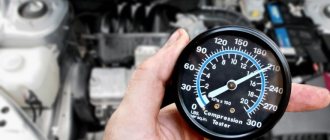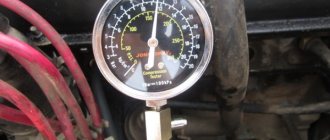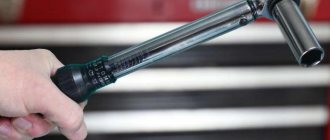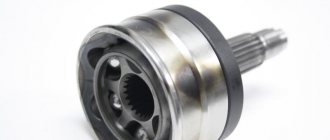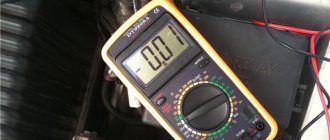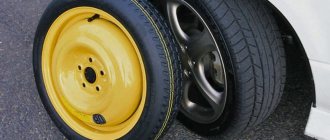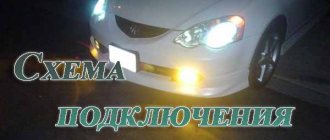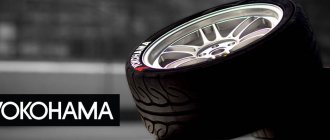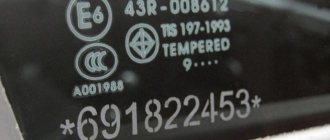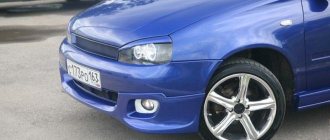Headlight markings can give a lot of information to the car owner, for example, about the type of lamps that can be installed in them, their category, the country where official permission for the production of such headlights was issued, the type of light emitted by them, illumination (in lux), direction of movement and even the date of manufacture . The last element is very interesting in the context that using this information you can check the real age when buying a used car. Individual manufacturers of car headlights (for example, KOITO or HELLA) have their own designations, which are useful to know when purchasing them or buying a car. The following material provides information about a variety of markings for LED, xenon and halogen headlights.
- International approval mark. In this case, approved in Germany.
- The letter A means that the headlight is a front light or a side light.
- The combination of HR symbols means that if a halogen lamp is installed in the headlight, it will only be for high beam.
- The DCR symbols mean that if the lamp is equipped with xenon lamps, they can be designed for both low and high beam.
- The so-called leading fundamental number (GN). Values of 12.5 and 17.5 correspond to a low high beam intensity.
- The arrows indicate that the headlight can be used on cars designed to drive on roads with right- and left-hand traffic.
- The PL symbols inform the car owner that a plastic lens is installed on the headlight.
- The IA symbol in this case means that the headlight has a reflector for motor vehicles.
- The numbers above the arrows indicate the percentage of angle at which the low beam should be scattered. This is done to make it easier to adjust the luminous flux of the headlights.
- The so-called official approval. It indicates the standards to which the headlight meets. The numbers indicate the homologation (update) number. Each manufacturer has its own standards and also complies with international ones.
Headlight markings by category
A marking is a clear, indestructible symbol of international approval, where you can find information about the country that gave the approval, the category of the headlight, its number, the type of lamps that can be installed in it, and so on. Another name for marking is homologation, a term used in professional circles. As a rule, markings are applied to the lens and headlight housing. If the lens and headlight are not included in the kit, then the corresponding markings are applied to its protective glass.
Now let's move directly to the description of the types of headlights. So, they come in three types:
- headlights for traditional incandescent lamps (nowadays they are becoming increasingly rare);
- headlights with halogen lamps;
- headlights for xenon bulbs (aka gas discharge lamps/headlights);
- diode headlights (another name is ice headlights).
Incandescent lamps . The letter C indicates that they are intended for low beam, the letter R means high beam, the combination of letters CR means the lamp can emit both low and high beam, the combination C/R means that the lamp can emit either low or high beam (Rules UNECE No. 112, GOST R 41.112-2005).
Halogen lamps . The combination of letters HC means that it is a low beam lamp, the combination HR means that it is a lamp for high beam, the combination HCR means that the lamp is both low and high beam, and the combination HC/R is a lamp for either low beam or high beam (UNECE Regulation No. 112, GOST R 41.112-2005).
Xenon (gas discharge) lamps . The combination of letters DC means that the lamp is designed to emit low beam, the combination DR means that the lamp emits high beam, the combination DCR means that the lamp is both low and high beam, and the combination DC/R means that the lamp is either low or high beam (Rules UNECE No. 98, GOST R 41.98-99).
The HCHR marking on Japanese cars means HID C Halogen R, that is, low beam xenon, high beam halogen.
Since October 23, 2010, it is officially permitted to install xenon headlights on a car. However, it is necessary to have a headlight washer and auto-corrector. At the same time, it is desirable that employees of state traffic police agencies make appropriate notes about the features introduced into the design of the vehicle in the “special notes” column of the STS/PTS.
The best lamps for cars
Find out which bulbs to install in your car's headlights. Ratings are given for popular lamps in h1, h4 and h7 sockets. The lists are compiled based on measurements of the physical indicators of lamps and their characteristics Read more
Optics for xenon
The markings on xenon headlights consist of the following letters:
- DC;
- DR;
- DC/R.
The first letters D indicate the use of gas-discharge sources in conjunction with lenses or special reflectors.
It is not recommended to independently install xenon in foglights and headlights with codes HC, HR, HC/R. This can not only harm the car's wiring, but also damage the reflector. The use of xenon is also prohibited in taillights.
International approval marks
All licensed lamps installed in modern cars have certain certification. The most common standards are the following: the letter “E” corresponds to the European standard, the abbreviation DOT (Department Of Transport - Department of Transport of the United States of America) is the first American standard, the combination SAE (Society Of Automotive Engineers) is another standard according to which , including motor oils.
When marking headlights, just like when marking lamps, a specific number is used to designate countries. The relevant information is summarized in a table.
| Number | The name of the country | Number | The name of the country | Number | The name of the country |
| 1 | Germany | 13 | Luxembourg | 25 | Croatia |
| 2 | France | 14 | Switzerland | 26 | Slovenia |
| 3 | Italy | 15 | not assigned | 27 | Slovakia |
| 4 | Netherlands | 16 | Norway | 28 | Belarus |
| 5 | Sweden | 17 | Finland | 29 | Estonia |
| 6 | Belgium | 18 | Denmark | 30 | not assigned |
| 7 | Hungary | 19 | Romania | 31 | Bosnia and Herzegovina |
| 8 | Czech Republic | 20 | Poland | 32…36 | not assigned |
| 9 | Spain | 21 | Portugal | 37 | Türkiye |
| 10 | Yugoslavia | 22 | Russian Federation | 38-39 | not assigned |
| 11 | Great Britain | 23 | Greece | 40 | Republic of Macedonia |
| 12 | Austria | 24 | not assigned | — | — |
Most headlights also have the logo of the manufacturer or brand under whose sign this or that product was produced. Similarly, the location of the manufacturer is indicated (often this is simply the country where the headlight was manufactured, for example, Made in Taiwan), as well as the quality standard (this can be either an international standard, for example, ISO, or internal quality standards of that or other specific manufacturer).
How to legally install LED bulbs in headlights?
According to the law, if you make changes to the design of the car, then you have the right to operate the car on public roads only after going through a certain procedure in legalizing the installed equipment in the traffic police and in specialized organizations.
We discussed in more detail how to formalize the conversion of a car in the article “Fine for gas equipment in a car.” Let us recall that in this article we examined the process of legalizing the installation of gas equipment on a vehicle.
When installing LED lamps in a car, you will first need to re-equip the headlights in a specialized organization, which will install the appropriate lenses and other equipment in them that will provide the LED lighting with an optimal beam of light projected onto the road.
Also, to legally register LED optics, you need to obtain permission to re-equip the car.
In particular, after installing / altering the headlights in a specialized organization, you must register the re-equipment of the car with the State Traffic Safety Inspectorate and obtain a certificate of compliance of the vehicle with the changes made to its design in accordance with safety requirements.
Read more about the process itself here.
Type of light emitted
Typically, information about the type of light emitted is indicated somewhere in the immediate vicinity of the circled symbol. So, in addition to the above types of radiation (halogen, xenon, LED), there are also the following designations:
- Letter L. This designates the light sources for the rear license plate of a car.
- The letter A (sometimes combined with the letter D, which means that the homologation refers to a pair of headlights). The designation corresponds to front marker lamps or side lamps.
- The letter R (similarly, sometimes in combination with the letter D). This is the designation for the rear parking light.
- Combinations of characters S1, S2, S3 (similarly, with the letter D). This is how brake lights are designated.
- Letter B. This is how the front fog lights are designated (in Russian designation - PTF).
- Letter F. The designation corresponds to the rear fog lamp, which is mounted on cars, as well as towbars.
- Letter S. The designation corresponds to an all-glass headlamp.
- Designation of the front turn signal 1, 1B, 5 - side, 2a - rear (they emit orange light).
- Turn signals also come in a transparent color (white light), but they shine orange due to the orange lamps inside.
- AR symbol combination. This is how reversing lights installed on cars and trailers are marked.
- Letters RL. This is how fluorescent lamps are marked.
- Combination of letters PL. These symbols correspond to headlights with plastic lenses.
- 02A - this is how the sidelight (size) is designated.
It is interesting that cars intended for the North American market (United States of America, Canada) do not have the same designations as European ones, but they do have their own. For example, turn signals on American cars are usually red (although there are others). The symbol combinations IA, IIIA, IB, IIIB are reflectors. Symbol I corresponds to reflectors for motor vehicles, symbol III corresponds to towed devices, and symbol B corresponds to built-in headlights.
According to the rules, side marker lights must be installed on American cars longer than 6 meters. They are orange in color and designated SM1 and SM2 (for passenger cars). The rear lights emit a red light. On trailers it is necessary to install a triangular reflector, designated IIIA, and contour lights.
Often the information plate also contains information about the initial angle of inclination at which the low beam should be scattered. Most often it is within 1...1.5%. In this case, there must be a tilt angle corrector, since with different loads of the car, the angle of illumination of the headlights also changes (roughly speaking, when the rear of the car is heavily loaded, the main luminous flux from the headlights is directed not at the road, but directly in front of the car and even slightly upward ). In modern cars, as a rule, this is an electronic corrector, and they allow you to change the corresponding angle directly from the driver’s seat while driving. In older cars, this angle must be adjusted directly in the headlight.
Some headlights indicate the SAE or DOT standard number (European and American automaker standards).
Which lamps to choose
In order to choose the right light bulb for a particular lighting, you need to understand the headlight markings printed on its body.
The markings of already installed headlights can be seen by looking under the hood on the inside of the glass. In some cases, this will require removing the headlight.
The country that has approved the optics is indicated by a letter and number surrounded by a circle. If there is an E in the circle, this means that the approval was received from a European country.
If the abbreviation DOT is circled, then the statement refers to the United States of America. By the way, DOT stands for Department of Transport.
The number next to the letter indicates the country itself. Each country has its own serial number.
The presence of arrows in the marking indicates the purpose of the headlight when using the vehicle in left-hand traffic.
If there is no such marking, then, accordingly, the headlights are intended for right-hand traffic. If there are two arrows at the same time, the headlight is designed for both types of movement.
In fact, the marking carries a huge amount of information, for example, about the manufacturer (in this case, Hella).
If we look at our marking image, the first abbreviation DC indicates the possibility of installing xenon low beam.
In addition, there may be such symbols characterizing other xenon lighting (DR, DC/R), lamps with an H4-halogen base (HC, HCR, HC/R), and conventional incandescent lamps (C- low, R- far, CR - near and far, C/R - near or far illumination).
On the left side of the circle indicating the country, there is a number indicating the coverage area. In our case, this figure is 20 square meters.
The letter A means that the headlight is considered a side light (if there is a B symbol, the headlight will be considered a fog light).
Every vehicle must have low beam starting angle information displayed on the headlight or on a placard located under the hood. This indicator is measured as a percentage and can vary from 1 to 1.5%.
If we talk about the international designation, the presence of the letter H in the marking indicates the use of the headlight only for halogen lamps. If the headlight is marked PL, then the lens is made of plastic.
But there are other designations, for example:
If everything is clear with the markings, then you can start choosing the light bulbs themselves. Today, the automotive market is full of a huge assortment of light bulbs from various manufacturers.
When choosing between xenon and halogen, you should know the typical characteristics and indicators of each lighting:
A xenon lamp guarantees the car owner good visibility of the road, despite bad weather conditions (rain and snow), as well as in the dark. The main advantage of such lighting is that there is no threat of vision impairment. Of course, if you don’t look at the headlight on for a long period. This characteristic applies more to the vision of drivers of oncoming vehicles and to xenon owners who drive in the dark, looking at the illuminated road. Xenon lighting is very similar to sunlight, so it is not an irritant to the human eye;
The operating time of a xenon lamp is a maximum of 3 thousand hours, while the power consumption will be equal to 35 volts. The disadvantage of a xenon bulb is its cost.
A halogen lamp is installed in headlights intended for headlights. A halogen lamp is an incandescent light bulb with an inert gas in the bulb. Lighting indicators, unlike halogens, have rather low characteristics. The resulting luminous flux and efficiency of such lamps are low.
However, their cost is quite reasonable, in contrast to the price of halogen lamps. The advantage of halogen is their durability, a huge range of different types and sizes.
Find out which is better to buy xenon for a motorcycle from this information.
Illuminance value
All headlights have a symbol indicating the maximum luminous intensity (in lux) that a headlight or pair of headlights can produce. This value is called the leading base number (abbreviated as leading base number). Accordingly, the higher the VOC value, the more intense the light emitted by the headlights and the greater the range of its propagation. Please note that this marking is only relevant for headlights that have both low and high beams.
In accordance with current standards and regulations, all modern manufacturers are not allowed to produce headlights with a leading base number value exceeding 50 (corresponding to 150 thousand candelas, cd). As for the total total light intensity emitted by all headlights installed on the front of the car, it should not exceed a VOC equal to 75, or 225 thousand candelas. Exceptions include headlights for special equipment and/or closed sections of roads, as well as sections significantly removed from sections of the road used by ordinary (civilian) transport.
Design of xenon lamps
Today, two types of such lamps are common, with different designs:
- A spherical flask made of quartz glass, which is the only modern type of material that has an acceptable cost and can withstand high pressure. Two tungsten electrodes are built into it; the function of contacts conducting electric current is performed by cylindrical leads. With their help, you can attach the flask to an existing system or connect wires. The bulb itself is filled with xenon at a pressure of 8-9 atm; during operation of the lighting device, its performance increases 2.5 times. The design of individual modifications includes a massive anode, which allows operation at direct current.
- Tubular flask with natural cooling method. The material is also thick quartz glass; tungsten electrodes are located at opposite ends of the flask. Molybdenum foil is used for inputs, and steel is used for external outputs; adapter bushings are made of titanium. The xenon pressure with which the flask is filled can range from 15 to 330 mm Hg. Art.
Direction of movement
This marking is relevant for cars with right-hand drive, that is, for those that were originally intended for driving on roads with left-hand traffic. This function is marked with arrows. So, if in the symbol on the headlight there is an arrow pointing to the left, then, accordingly, the headlight should be installed in a car designed to drive on roads with left-hand traffic. If there are two such arrows (directed both to the right and to the left), then such headlights can be installed on cars for roads with both left-hand and right-hand traffic. True, in this case additional adjustment of the headlights is necessary.
However, in most cases, the arrows are simply missing, which means that the headlight must be installed on a car designed to drive on right-hand drive roads. The absence of an arrow is due to the fact that there are more right-hand traffic roads in the world than left-hand ones, and the same applies to the corresponding cars.
General information
In addition, failure to comply with labeling requirements can lead to poor lighting quality, because headlights not intended for this purpose cannot ensure the normal operation of xenon and the concentration of the light emitted by it, which is necessary for the effective use of such lighting devices.
Marking is the designation of headlight features, expressed in letters and numbers, which tell the consumer what can be mounted in this optics so that it performs its tasks as efficiently as possible, without interfering with other motorists.
Marking is useful for craftsmen who immediately understand which lamps can be used in it and which additional devices may well be used to ensure operability.
Initial data
For example, in Japan the HC/HR marking is used - the same as in European cars, but if in an Asian country this means the headlight is suitable for xenon in low and high range modes, then in European cars such a designation will be a complete ban on xenon lamps and their intended purpose headlights are strictly for halogen lamps.
Therefore, if the car is Japanese, but is used in European countries, in particular in Russia, then you need to have with you certain documents explaining the meaning of the marking.
You should not ignore the markings on the headlights, because if its requirements are violated, you may not only not get high-quality light, but also dazzle other drivers, which is not only unpleasant, but also dangerous, since it creates an emergency situation and can provoke a real tragedy.
Their design
The task of collecting light into a beam is taken care of by a reflector, which receives all the rays and directs them in a certain direction, amplifying them many times over.
At the same time, there is also a corrector for the xenon headlight, which limits the light zone, directing the beam forward.
The xenon lamps themselves are made in the form of a flask containing two electrodes, and its internal space itself is filled with a noble inert gas - xenon.
We recommend: How to clean spark plugs from carbon deposits at home
When the light bulbs are turned on, the ignition unit, which is located separately from the light bulb, is triggered and produces a voltage of 25 thousand volts through the wires, which enters the flask, and at the same time the gas begins to glow, and its light is directed in the desired direction using a corrector.
The legislative framework
The same applies to individual technical elements, including headlights. Thus, when a headlight that is not intended for xenon and does not have the appropriate marking contains a xenon lamp, this is a violation of established standards.
But the 2022 law does not stipulate xenon marking on headlights, since this has not been adopted.
But a person who was noticed operating a car in which the lighting devices do not correspond to the markings or they were even replaced without coordination with the technical authorities of the traffic police risks being punished.
This is evidenced by the Code of Administrative Offenses of the Russian Federation and its Article 12.5, which even provides for deprivation of rights if the presence of light bulbs not intended for this device is proven by technical experts.
Official approval
Many (but not all) headlights contain information about the standards to which the product meets. Moreover, this depends on the specific manufacturer. As a rule, information about standardization is located under the symbol within the circle. Usually information is stored in a combination of several numbers. The first two of them are the modifications that this headlight model has undergone (if any, otherwise the first digits will be two zeros). The remaining numbers are the individual homologation number.
Homologation is an improvement of an object, improvement of technical characteristics in order to comply with any standards or requirements of the consumer country of the product, obtaining approval from an official organization. Homologation has very rough synonyms “accreditation” and “certification”.
Many car enthusiasts are interested in the question of where exactly they can look up information about the labeling of new or already installed headlights on their car. Most often, the relevant information is applied to the upper part of the headlight housing, in particular, under the hood. Another option is that the information is printed on the inside of the headlight glass. Unfortunately, for some headlights the information cannot be read without first removing the headlights from their mounting location. This depends on the specific car model.
LED optics
On public highways, cars with LED light sources are increasingly being seen. Marked ice lenses cover a large area of the road and can last more than 10,000 hours.
Many car owners are interested in the question of what is the marking of LED headlights from the factory and whether it is possible to independently install diodes instead of halogen or xenon. Optics with diodes have the inscription HCR, indicating conventional halogen lamps. However, the code for all reflectors and lenses additionally contains the LED prefix, and their design is significantly different.
In daytime running lights, the lamp is built into the housing without any markings. The location of the lights is regulated by the transport safety guidelines.
Knowing the location of the markings allows you not only to detect the replacement of a headlight due to an accident, but also to protect yourself from fines by using the right lamps.
Xenon headlight markings
In recent years, xenon headlights have become very popular among domestic car enthusiasts. They have a number of advantages over classic halogen light sources. They have a different type of base - D2R (the so-called reflector) or D2S (the so-called spotlight), and a glow temperature below 5000 K (the number 2 in the designation corresponds to the second generation of lamps, and the number 1, respectively, to the first, but they are currently found infrequently for obvious reasons). Please note that the installation of xenon headlights must be carried out correctly, that is, in accordance with current rules and regulations. Therefore, it is better to install xenon headlights in a specialized auto repair shop.
The following are specific designations for halogen headlights, with the help of which it is possible to determine whether xenon light can be installed instead:
- DC/DR. This headlight has separate low and high beam sources. Moreover, such designations can also occur on gas-discharge lamps. Accordingly, instead of them you can put “xenon lights”, but in accordance with the rules mentioned above.
- DC/HR. Such headlights are designed to install gas-discharge lamps for low-beam lighting. Accordingly, such lamps cannot be installed on other types of headlights.
- HC/HR. This marking is installed on the headlights of Japanese cars. It means that instead of halogen headlights, xenon ones can be mounted on them. If a similar inscription is on a European or American car, then the installation of xenon headlights on them is prohibited! Accordingly, only halogen headlights can be used for them. Moreover, this applies to both low and high beam lamps.
Sometimes numbers are written before the characters mentioned above (for example, 04). This number indicates that changes have been made to the documentation and design of the headlights in accordance with the requirements of the UNECE Regulations with the number indicated before the mentioned symbols.
As for the places where information about the headlight is printed, xenon light sources can have three of them:
- directly on the glass from its inside;
- on top of the headlight cover, made of glass or plastic; to study the relevant information, it is usually necessary to open the hood of the car;
- on the back of the glass cover.
Xenon lamps have a number of individual designations. Among them are several English letters:
- A - lateral;
- B - anti-fog;
- C — low beam;
- R - high beam;
- C/R (CR) - for use in headlights as sources of both low and high beam.
Sticker for xenon headlights
Samples of various stickers
Recently, among car enthusiasts whose cars are equipped with xenon headlights not from the factory, but during operation, the topic of making headlight stickers on their own is gaining popularity. In particular, this is true for xenon lenses that have been altered, that is, normal xenon lenses have been replaced or installed (for optics without changes, the corresponding sticker is made by the manufacturer of the headlight or car).
When making stickers for xenon headlights yourself, you must know the following parameters:
- What kind of lenses were installed - bilens or regular mono.
- The bulbs used in the headlight are for low beam, high beam, turn signal, running lights, type of base, and so on. Please note that for Chinese Plug-n-play lenses, you cannot indicate the Chinese lens and halogen base (type H1, H4 and others) on the sticker. Also, when installing them, it is necessary to hide their wiring, since by their appearance (installation) you can easily identify such devices, and get into trouble when checked by employees of the State Road Service.
- Geometric dimensions of the sticker. It must fit completely on the headlight housing and provide complete information when looking at it.
- Manufacturer of headlights (there are a lot of them nowadays).
- Additional information, such as the production date of the headlights.
International marking designation
The lighting equipment of any wheeled vehicle must be marked with an alphabetic or digital code. All auxiliary elements - ignition blockers, correctors, lenses, diffusers - are marked with certified markings in accordance with international standards 41.99-99.
The code must meet the following parameters:
- be clear, easy to read;
- be in a visible place;
- have comprehensive information about the manufacturer, the angle of the light beam, certification;
- contain a designation whose arrows indicate the month and year of production.
With the help of decoding, you can determine whether car optics were changed due to a serious accident.
International approval mark
Optical instruments from different countries differ in luminous flux, as well as in the direction of the cut-off angle. The necessary information is contained on the optics body in the form of a sticker or molding on plastic.
In the classic version, optics are marked with five main designations:
- headlight type;
- used lighting elements;
- region-specific compliance;
- intended for different directions of movement;
- manufacturer.
Manufacturers apply technical information to the bottom edge of the glass. You do not need to open the hood to view the necessary information.
Anti-theft headlight markings
Like windshields, car headlight lenses are also marked with a so-called VIN code, the purpose of which is to identify a specific glass in order to minimize the risk of theft of the headlight. This is especially true for expensive foreign cars from world-famous manufacturers, the cost of headlights of which is quite high, and either there are no analogues or they also have a considerable price. Typically, the VIN is engraved on the headlight housing. Identical information is entered into the technical documentation of the vehicle. Accordingly, when checking the vehicle configuration of a traffic police officer, if the code value does not match, they may have questions for the car owner.
The VIN code itself is a seventeen-digit code consisting of letters and numbers, and is assigned by the car manufacturer or the manufacturer of the headlight itself. This code is also duplicated in several places on the car body - in the cabin, on the nameplate under the hood, under the windshield. Therefore, when purchasing certain headlights, it is advisable to choose light sources on which the VIN code is clearly visible and all information about the product is known.
Difference between xenon and halogen lamps
The main difference is in the light source: halogen lamps are designed with an incandescent filament, while gas-discharge models use an electric arc.
The bulbs of xenon lamps are filled with a special mixture of gases; xenon has the highest concentration; the brightness of such lighting devices is much higher than that of their halogen counterparts. In addition, they create more natural lighting, which in its characteristics is closest to daylight, while halogen lamps do not have this opportunity.
Based on the information provided in the article, we can conclude that xenon lamps have many advantages when compared with analogues, which fully justifies their cost. However, you should first make sure that their installation is legal in order to pass a technical inspection of the vehicle without any problems and not pay fines.
Installing xenon on Ford
The high quality of Ford cars and practicality of operation are sometimes limited by weak head optics. Low and high beams affect not only comfort, but also the safety of the trip. A reasonable solution would be to install xenon, which will significantly increase the reliability of the optics. This is an effective technology that will be safe and durable if done correctly.
How to choose the right xenon for Ford Focus 2
Manufacturers of xenon headlights offer such a wide selection of their products that you can get lost in its diversity. This will not happen if you follow one rule: select only the lighting that matches the color temperature parameters. In this case, the search circle is significantly narrowed, and any Ford Focus 2 car owner will be able to choose headlights for his car, guided by:
- design features;
- technical values;
- operational properties;
- price characteristics.
And installing xenon lamps is no more difficult than, say, rebuilding a suspension or replacing a caliper.
If you want rich light with a stylish design, pay attention to a model such as “angel eyes”. The luminous edge of the headlight creates not only a spectacular, but also a powerful light beam. The cold cathode included in the lighting device ensures uninterrupted operation of this equipment and a long period of its operation.
For those who are interested in a budget option, the Korean Matrix Light headlight kit is more suitable. The manufacturer provided xenon only for the low beam, leaving the high beam as halogen. However, thanks to the minimum period of ignition of the lamp, the flashing of the main beam is very impressive, and the xenon light gives the feeling of daylight. With a color temperature of 4310-6010 K, you will get bright, stable lighting while keeping energy costs to a minimum.
The Koreans have adapted their products to the Russian consumer, adapting them to our weather conditions, combining them with electronics, making units with rational dimensions, and delighting car enthusiasts with a variety of lamp bases. Time-tested and world-famous manufacturers monitor the quality of their product, therefore all officially released xenon equipment is necessarily equipped with ISO certificates of international format.
By installing xenon, you will receive the following benefits:
- excellent vibration resistance;
- good tolerance to mechanical loads;
- quick start over a wide temperature range;
- compact control unit;
- moisture-resistant wires coated with silicone;
- increased noise immunity.
All connectors are made with an improved degree of protection and reliability. Xenon headlights on Ford Focus 2 may have a different glow. At a color temperature of about 5000 K it will be white, at 6000 K it will be bluish.
What is the marking for and what does it mean?
First of all, the markings on the headlamp help the driver decide what type of light bulbs can be installed to replace burnt ones. In addition, the label contains a large amount of additional information: from the year of manufacture to the country of certification, as well as information about compliance with standards.
Car headlight markings
According to the international standard (UNECE Rules N99/GOST R41.99-99), optical equipment installed on wheeled vehicles (cars) must be marked according to an approved model.
The code, which contains letters of the Latin alphabet, deciphers all the information about the car headlight:
- the type of lamps intended for installation in a specific unit;
- model, version and modification;
- category;
- lighting parameters;
- direction of the light flux (for the right and left sides);
- the country that issued the certificate of conformity;
- date of manufacture.
In addition to the international standard, some companies, for example, Hella and Koito, use individual markings that indicate additional equipment parameters. Although their standards do not contradict international rules.
The marking is melted onto a plastic sidelight and duplicated on the back side of the body under the hood in the form of a sticker. The protected sticker cannot be removed and reinstalled on another product without damage, so low-quality optics often do not have full markings.
Main functions
The marking serves so that the driver or technician can immediately find out information about the optics used. This helps when the same model in different trim levels is equipped with several modifications of headlights.
Marking location
If the device is non-separable, then markings are usually applied to the glass inside or outside. It can be cast, engraved, or permanently inked.
If the glass is removable, then the markings are applied to the lantern body by casting (stamping) or paint.
In some cases, the marking is applied in the form of a sticker on the body or glass of the lighting device. If the sticker is placed on glass, then it has a transparent base and does not block the light flux.
Has anyone installed LED lamps on standard ff2 headlights?
Excuse me, are you idiots? What kind of karma are you spoiling there?) this is an ordinary lamp, not xenon, learn to adjust the headlights in height! Or buy glasses for night trips, those sissies are sick of them! As for the question, you don’t need any lenses, there are no problems with them, a friend has them in a Chevrolet Niva, they asked me to take them out once, just to make sure that they weren’t xenic. We're fed up with grandfathers or young people squeaking that everything doesn't suit them.
Maxim, pfft standard lamps. Despite the fact that the headlights are already foggy
Anton, it’s immediately clear that all the drivers curse you
Andrey, no one will curse me. Why is this in the first place?) and secondly, I have standard lamps
I sat there writing to explain, and then I thought and... Fuck it. no one gives a fuck anyway. Ride as you wish. I personally don’t give a damn who has which lamps. )
Andrey, they are still down. They need to be adjusted
Maxim, do you have LED lamps? I also wanted to put them on low beam, but they told me that they don’t shine well.
You don’t need to change anything, put it in regular optics, from the point of view of the law - there is no violation. From the point of view of oncoming vehicles - I don’t know
It blinds oncoming traffic. On damp asphalt you can’t see anything at all. Do you want good light? Install lenses On second Fords it’s just a problem with the light from conventional headlights
Ilya, the discrepancy between the operating mode of the headlight and the type of lamp is not provided for by the manufacturer of your car, respectively, deprivation of the right to drive the vehicle from 6 to 12 months with confiscation of lamps. Why mislead people, read article 12.5 clause 3 of the Code of Administrative Offenses
Ilya, from the point of view of the law, the violation is the same as for xenon. Halogen headlights have an LED light source, but should have an incandescent lamp. Diodes require their own optics, which are not cheap. Good luck to all.
How to install xenon on Ford Focus 2 restyling?
The following is an excerpt from the article. Loosen the 4 locking latches.
By removing the terminals, you will have access to the standard standard lamp, which must be removed. To route the wiring for the xenon, drill a hole in the rear wall. It should be of such a size as to accommodate the wires and a rubber seal that protects the wiring from the negative effects of vibration.
Make the hole in such a way that the wires do not come into contact with the plastic surface. After this, you can attach the ignition unit. It is mounted under the hood, under the headlights of Ford Focus 2.
It is likely that you will see already installed fasteners there, carefully provided by the manufacturer. This makes the task much easier.
Sources
- https://yubus.ru/ustanovka-ksenona-ford-fokus-2
- https://avto-all.com/amerikanskie-avtomobili/faryi-ford-focus-2-samostoyatelnaya-ustanovka-ksenona-na-avtomobil
- https://AutoLions.ru/tyuning/markirovka-far-ford-fokus-2.html
- https://FordProf.ru/focus-2/kak-ustanovit-ksenon-na-ford-focus-2-restajjling.html
- https://auto-park24.ru/uhod/ustanovka-ksenona-ford-fokus-2.html
- https://my-class.ru/kak-ustanovit-ksenon-v-protivotumanki-na-ford-fokus-2-restayling/
- https://kalina-2.ru/remont-vaz/shtatnyj-ksenon-ford-fokus-2
[collapse]
Selecting a suitable set of headlights for a Ford Focus
Let's figure out how to install xenon on a Ford Focus 2 restyling, doing all the necessary procedures yourself. Let’s immediately make a reservation that the whole process will certainly not be more difficult than repairing the suspension of a Ford Focus 2 when you read to the end. From the very beginning, xenon installation begins with choosing the right headlight. There is a huge number of xenon assortments on the auto parts market, which differ in cost, technical characteristics, design capabilities and performance quality. An ordinary car enthusiast himself can figure out the choice of the right equipment, but for the Ford Focus 2 it is necessary to choose xenon lighting that matches the color temperature values.
With special xenon headlights in the shape of angel eyes, you can get high-quality light and an original design. With this model of headlights, the effect is that the edge of the headlight in the car glows, resulting in a rich, powerful light, and the car itself is filled with modern design. With the help of a cold cathode, which is part of the angel eyes, the equipment will be of high quality and durable.
There is an inexpensive but high-quality kit from Korean manufacturers - Matrix Light xenon, which has xenon low beam and halogen high beam. With the help of xenon, the lamp ignition time will be minimized, this affects the spectacular blinking of the high beam headlights. The color temperature is 4300-6000 K. With such equipment, you can get excellent visibility at any time of the day, intense bright lighting with minimal energy consumption. The emitted light from xenon will be completely similar to daylight.
The kit is made specifically for Russian consumers, with the required block size, variety of base lamps, climatic conditions and compatibility with electronic equipment. Official xenon equipment is confirmed by an international ISO certificate, which monitors the quality of the manufactured product.
The features of xenon include: fast start-up, regardless of temperature, resistance to vibrations in the car and mechanical loads. It has a compact control unit, high-precision silicone-coated wires, and a connector with increased reliability, moisture resistance and high noise immunity.
Photo of xenon Ford Focus 2
The selected Ford Focus 2 restyled xenon headlight can come with a bluish glow, usually this is a 6000 K kit. For a white xenon glow, the color temperature should be 5000 K. The headlight kit includes electrical equipment, with an included ignition unit, fasteners and wiring, which supplies voltage. The ignition unit must be installed in the engine compartment, under the xenon headlights.
